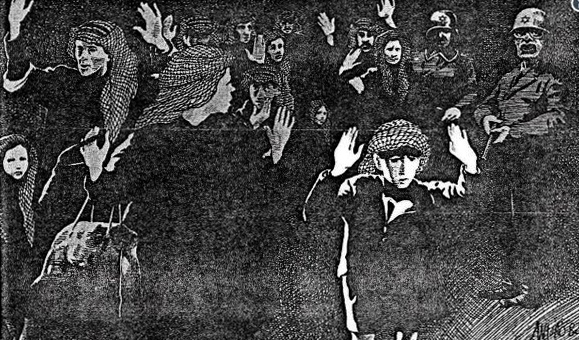Editor’s note: Hebrew University’s Dr. Yoram Yovell is a psychiatrist, neuroscientist, TV talk-show host and international speaker. He works in the Division of Clinical Neuroscience of Hadassah Medical Center and at HU’s Department of Psychology. He will be speaking in Vancouver on July 25, 2019 about “The Science of Happiness“.


I’m no great fan of President Donald Trump or Prime Minister Benjamin Netanyahu, and yet, I was taken aback by the now-infamous cartoon that appeared in The New York Times International Edition on April 25.
It featured a blind, fat Trump, wearing dark glasses and a black skullcap, being led by a Netanyahu-faced dachshund, wearing a Star of David collar. Like most of my countrymen, I did not find that caricature amusing. Not even a little bit.
But have no fear: The man who drew it, veteran Portuguese cartoonist António Moreira Antunes, doesn’t need to go into hiding now. Unlike the 12 journalists at the French satirical newspaper, Charlie Hebdo, who were murdered by Islamic extremists in 2015 for publishing cartoons of the prophet Mohammed, or the 12 Danish artists who were forced to go into hiding after they published similar cartoons in 2006, he is in no danger of being tracked down and targeted by angry assassins.
 António Moreira Antunes cartoon from 1982
António Moreira Antunes cartoon from 1982
He was in no such danger in 1982, either, when he published a caricature depicting Israeli soldiers as Nazi stormtroopers, torturing Lebanese women and children. It was a cruel twist on a haunting photo, taken in the aftermath of the Warsaw ghetto revolt in 1943, in which smiling Nazi soldiers lead a group of frightened Jewish women and children to their death.
The worst Antunes may face for his ugly cartoons is bad press, and that isn’t necessarily bad. As both Trump and Netanyahu know all too well, the adage, “There’s no such thing as bad publicity,” has never been more true.
But the Trump-Netanyahu cartoon raises two questions that beg to be addressed seriously: How do you decide whether a cartoon about Jews or Israel is a legitimate form of political satire, or blatant anti-Semitic propaganda? And how do you treat anti-Semitic bias in order to minimize it, rather than make it more defiant and thus stronger?
In his 1964 ruling on the Jacobellis v. Ohio case, U.S. Supreme Court Justice Potter Stewart famously described his threshold test for “hard-core pornography”:
“I shall not today attempt further to define the kinds of material I understand to be embraced within that shorthand description , and perhaps I could never succeed in intelligibly doing so. But I know it when I see it.”
“I know it when I see it” quickly became one of the best-known phrases in the history of the U.S. Supreme Court, and it can be applied to anti-Semitism as well. But this phrase implies, in my opinion, that hard-core pornography, like hard-core anti-Semitism, is in the eye of the beholder.
Many years ago, I had an opportunity to witness that firsthand. I was born, raised, and studied medicine in Jerusalem, but I did my residency in psychiatry at Columbia University’s Presbyterian Hospital in New York.
Several of my classmates were American Jews. Once, in an evening get-together of the residents, all of whom were my close friends, we were standing in a circle and talking. After one of us (let’s call him Chris) left the group, another (let’s call him Isaac) remarked: “Did you hear what Chris said just before he left? I would never have guessed that he could say something so anti-Semitic.”
It was only then that I noticed that all of us in the group were Jewish, whereas Chris was not. I no longer remember what it was that Chris had said, but I do remember that I found nothing anti-Semitic in it, and I told my friends so.
“Yoram, you’re from Israel. You guys don’t notice these things like we American Jews do,” they replied. In a flash, I realized what a success the Zionist project had been. Within two generations (my parents were born in Israel, but my grandparents came from Europe), Israel had cured the Jews of their heightened sensitivity to anti-Semitism. But that was many years ago. Thanks to people like António Moreira Antunes, Jeremy Corbyn, and many others, we Israelis are catching up fast with our brethren in the diaspora.
So, how do you know whether the cartoon you are about to publish is anti-Semitic? My suggestion: Think of the images and associations it was meant to evoke. If they resemble, even remotely, any anti-Semitic slogans or images, then don’t do it.
I served in the Israel Defense Forces (IDF) and fought in Lebanon in 1982, so I was one of the soldiers who were portrayed by Antunes as sadistic Nazi stormtroopers. In the IDF, we used to have a saying: “When in doubt, there is no doubt,” i.e., if you are not sure whether something might go wrong or misfire, assume that it will, and take all the necessary actions to prevent it from happening.
This is how the media can recognize and avoid anti-Semitic comments and imagery. But how do you make the media want to do that? How do you make people, including cartoonists, stop recycling old, offensive anti-Semitic garbage?
One way is the ISIS way. I haven’t noticed any caricatures of Mohammed appear in the international media lately. People like Antunes have come to realize that it’s much safer to be anti-Semitic than to be anti-Muslim, and they act accordingly. A beautiful Arab proverb sums up this tactic succinctly: “Love me. If you can’t love me, then respect me. And if you can’t love me and you can’t respect me, then fear me.”
This approach is simple and effective, but there’s another way to combat the current wave of anti-Semitism, and, in the long run, it works better. It begins with the realization that filth, false accusations, and fake news are all weapons of the weak. People resort to them when the truth doesn’t serve their purposes. However, at least some of the people who produce anti-Semitic filth, and most of the people who consume it, actually believe in it. How do you convince them otherwise?
Mahatma Gandhi, perhaps the most successful politician of the 20th century, famously commented that:
“Truth needs no publicity other than itself, and like a small stone thrown into a pond, its ripples will in time inevitably reach the circumference. The only thing to consider is the solidity and the weight of the stone.”
So, the best approach against anti-Semites such as António Moreira Antunes, Jeremy Corbyn, and the like, is not to produce more enraged and inflammatory rhetoric, but rather to speak softly, and carry a big stone.
Dr. Yoram Yovell is a psychiatrist, neuroscientist, television talk-show host, and international speaker. He works in the Division of Clinical Neuroscience of Hadassah Medical Center, and at the department of psychology of The Hebrew University in Jerusalem.